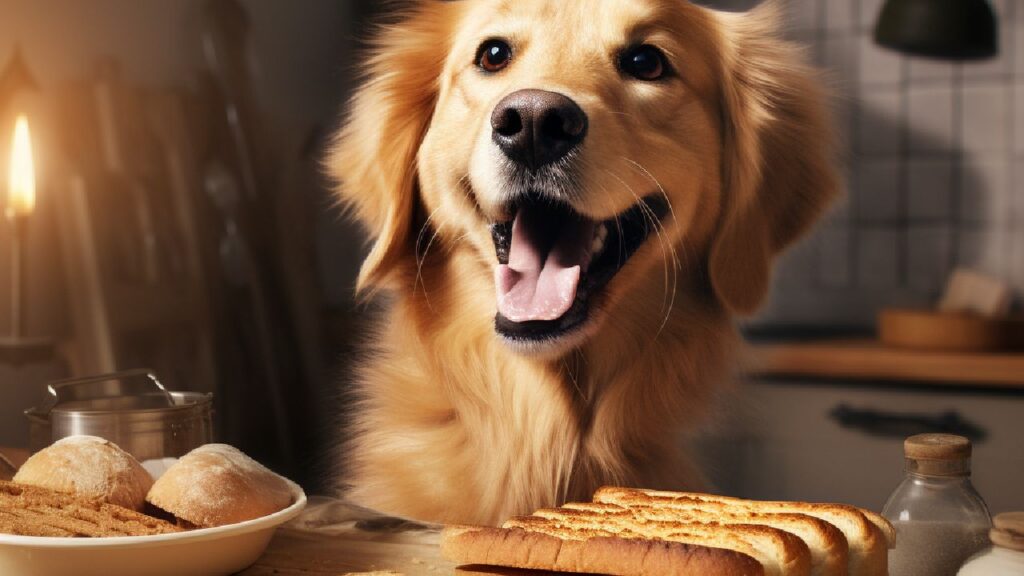Bread, a quintessential component of human diets, has long been at our tables. As we savor our sandwiches, toast, and rolls, our loyal furry companions often stand by, their curious eyes fixed on the delectable treat that has captured our taste buds for generations. The question arises: can dogs eat bread, too?
Yes, dogs can eat bread in moderation. Plain, unsalted, and unseasoned bread is generally safe for dogs to consume as an occasional treat. However, it should not be a significant part of their diet.
What’s Inside Bread?
Bread, at its core, is a mixture of flour, water, yeast, and sometimes other ingredients like salt and sweeteners. This composition translates into a carbohydrate-rich food that delivers energy to our bodies. For us humans, bread is a source of sustenance and an integral part of a balanced diet.
But when it comes to our canine companions, their nutritional needs differ significantly from ours. Dogs are primarily carnivores, meaning their bodies are adapted to thrive on a diet rich in animal-based proteins.
While carbohydrates can be a source of energy for dogs, their digestive systems are not optimized to process grains and complex carbohydrates like humans. Instead, dogs obtain the majority of their energy from protein and fats.
Bread’s Appeal to Dogs
Picture this: you’re sitting down to enjoy a sandwich, and your furry friend sits beside you, their eyes seemingly locked onto your every bite. It’s a familiar scene for many dog owners. The truth is dogs are attracted to the smell and taste of bread. The enticing aroma of freshly baked bread or the soft texture of a roll can trigger their natural curiosity and desire to sample what you’re enjoying.
However, it’s essential to consider that dogs’ attraction to bread doesn’t necessarily translate to it being a suitable or healthy dietary option for them. The same goes for other human foods.
Dogs are opportunistic eaters, and their inclination to investigate and consume various foods is deeply ingrained. As responsible pet owners, it’s our responsibility to ensure that the foods we offer align with our dogs’ nutritional needs and overall well-being.
Is It Safe for Dogs to Eat Bread?
Some dogs may have wheat allergies or sensitivities, so observing their reaction when introducing bread into their diet is essential.

The Potential Risks of Bread Consumption
While bread may seem innocuous, its dog safety is more complex. Dogs have different nutritional needs and digestive systems than humans, which can affect how they process various foods, including bread. One potential risk is that bread is calorie-dense, and consuming it without moderation could contribute to dog weight gain.
Furthermore, many commercially available breads contain additives, preservatives, and ingredients that might not sit well with your dog’s stomach.
Excessive consumption of bread, especially those with added sugars and fats, could lead to gastrointestinal upset, vomiting, or diarrhea in dogs. High sodium content in some breads is another concern, as excessive sodium intake can lead to health issues like dehydration and elevated blood pressure in dogs.
Dangers of Bread Dough
One aspect of bread that demands particular attention is bread dough. Bread dough contains yeast, a living organism that ferments the dough, causing it to rise. When ingested by dogs, the warm and moist environment of the stomach can cause the yeast to continue fermenting, producing carbon dioxide gas and alcohol.
This can lead to bloating, discomfort, and potentially life-threatening conditions like gastric dilation-volvulus (GDV), commonly known as “bloat.”
In addition to the risk of bloating, alcohol produced by yeast fermentation can be absorbed into the bloodstream, leading to alcohol poisoning. This can result in symptoms like disorientation, difficulty breathing, seizures, and even death.
Therefore, it’s crucial to prevent dogs from accessing bread dough and to seek immediate veterinary care if ingestion occurs.
What Types of Bread Can Dogs Eat?
If you’re considering sharing a small piece of bread with your dog, opting for plain, whole-wheat bread without additives or extras is essential. Whole wheat bread, in moderation, can provide some carbohydrates to your dog’s diet.
Remember that bread should only be a minimal part of their overall nutrition, as their primary energy source should come from animal-based proteins.
When offering whole wheat bread to your dog, ensure it’s free from additional flavorings, spices, or ingredients like raisins, nuts, and seeds, which can be toxic to dogs. Avoid breads with added sugars, fats, or artificial sweeteners, as these can lead to health issues.
Feeding Bread to Dogs: Dos and Don’ts
Maintaining portion control is crucial when offering your furry friend bread, as it should be an occasional indulgence rather than a staple in their diet to ensure their overall well-being.
Portion Control Matters
When it comes to feeding bread to dogs, moderation is the golden rule. While bread is not inherently toxic to dogs, its nutritional value is limited, and excessive consumption can lead to health issues.
If you share a small piece of plain, whole wheat bread with your dog, ensure it’s a rare treat and not a substantial part of their diet.
Bread should always be like high-quality dog food formulated to meet your canine companion’s dietary needs. Instead, consider using bread to provide occasional variety rather than a primary food source.
Avoiding Bread With Toxic Ingredients
It’s crucial to be aware of ingredients that are toxic to dogs and to read labels carefully. Bread varieties containing toxic ingredients like garlic, onion, raisins, nuts, and seeds should never be offered to dogs. Even a tiny amount of these ingredients can lead to serious health complications.

Safer and Healthier Alternatives to Bread
Consider replacing bread with dog-friendly fruits and vegetables like apple slices, blueberries, carrots, and cucumbers to provide your canine companion with a tasty and nutritious snack.
Natural Treats
When seeking alternatives to bread, natural treats are an excellent option. Many fruits and vegetables are safe for dogs and offer valuable nutrients that can contribute to their overall health.
Some dog-friendly fruits include apple slices (without seeds), blueberries, strawberries, and watermelon (without seeds or rind). Vegetables like carrots, cucumbers, and green beans are low in calories and make for satisfying, crunchy treats that many dogs enjoy.
Before introducing any new food into your dog’s diet, it’s essential to research and ensure that it’s safe for canine consumption. Also, always consult your veterinarian if you need clarification on whether a specific fruit or vegetable is appropriate for your dog.
Homemade Biscuits and Pup-Friendly Snacks
If you want to provide tailor-made treats for your dog, homemade biscuits and snacks can be an exciting and nutritious option. By preparing treats yourself, you have control over the ingredients, allowing you to avoid additives, preservatives, and potentially harmful substances.
Numerous recipes are available for dog-friendly biscuits, cookies, and frozen treats. Many recipes use ingredients like whole wheat flour, oats, peanut butter (ensure it doesn’t contain xylitol), and natural flavors.
You can customize treats based on your dog’s preferences and dietary needs. Always ensure that the treats are baked or prepared in a way that ensures their safety and digestibility for your furry friend.
Conclusion
Ultimately, the story of Bread and your canine companion is one of caution, consideration, and mindful choices.
By being aware of potential risks, understanding your dog’s nutritional needs, and exploring alternative treatment options, you can ensure that your furry friend enjoys a safe and well-balanced diet that supports their vitality and longevity.

FAQs
What about gluten-free bread? Can dogs eat it?
Dogs generally don’t require gluten-free diets unless they have a specific sensitivity or allergy. While gluten-free bread may not be harmful in moderation, check the ingredients for potential hazards.
Can I share a sandwich with my dog?
Sharing a sandwich with your dog is not recommended. Many sandwiches contain condiments, spreads, and flavorings that may harm dogs. Instead, make plain, whole wheat bread to offer your dog a small treat.
What should I do if my dog eats a lot of bread dough?
If your dog ingests raw bread dough, it can expand in its stomach and lead to serious health issues. Contact your veterinarian immediately if this happens. Do not induce vomiting, as yeast can continue to ferment and cause further problems.
Can I use bread to administer medication to my dog?
Using bread to hide medication is a common practice. While plain, small pieces of bread can be used, be cautious about using large amounts, as it could interfere with your dog’s overall diet and digestion.
How can I use bread for training purposes?
Bread can be a convenient training treat, but ensure it’s cut into small pieces to avoid overfeeding. Use bread alongside healthier treats like carrot sticks or lean meats for a balanced training reward.
Can I give my dog bread as a teething aid?
While a small piece of bread might temporarily relieve a teething puppy, there are safer alternatives, like frozen dog-safe fruits or chew toys designed for teething.






Hey there! Loved reading this article about dogs and bread. My pup Max goes crazy whenever he sees bread, but I’ve always wondered if it’s safe for him. Now I know to keep it in moderation and stick to plain whole wheat. Thanks for the info!